Friday was my last full day in Tasmania, and I'd accepted my travel agents suggestion to make a day trip to Port Arthur which had been pre-booked with 'Under Down Under Tours'.
I was picked up from my hotel at 7.30 a.m. by a charming Swiss driver/guide in a 15-seater Japanese minibus and, after more pick-ups, we set off towards Port Arthur. We made our first stop at the pretty village of Richmond, very English in appearance.
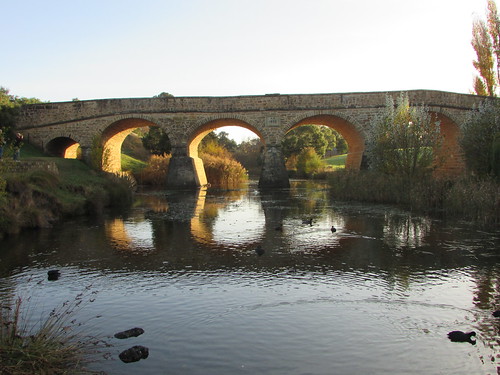
Richmond, Tasmania.
Further on, we stopped again for sea-views at Pirates' Lookout.

Pirates' Lookout.
Our final stop before the World Heritage Site at Port Arthur was at Port Arthur Lavender Farm, too late in the season (we were told) to see the floral displays. I tried the lavender-flavoured chocolate shavings samples but didn't feel impelled make a purchase.

Hobart to Port Arthur: Part of Port Arthur Lavender Farm.
Soon after leaving the Lavender Farm, we arrived at the Port Arthur Historic Site visitor centre which in in the process of being massively extended. Since becoming a World Heritage Site in 2010, visitor numbers have increased significantly.

Port Arthur Historic Site: The remains of the Penitentiary.
After a 40-minute orientation by an excellent guide, Andrew, we were free to explore.
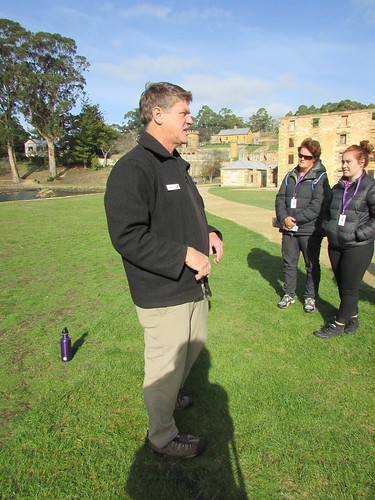
Port Arthur Historic Site: Site Guide Andrew.
I'm afraid I knew very little about the period of Transportation when large numbers of convicts from England, Ireland, Scotland, Wales and the British Empire were sent to Australia for imprisonment (partly to ease chronic overcrowding in British Gaols). Wikipedia has an article here and the official Port Arthur Historic Sites website here provides a lot of useful information, from which the notes below were condensed.
Sentences varied from seven years to life and those convicts who survived the harsh conditions and were released stood very little chance of ever being able to afford the passage back to their birthplace.
Port Arthur was established as a penal settlement and timber camp in 1830, extracting valuable timber. It has what has been described as "the finest natural harbour in the southern hemisphere", making it a suitable destination for ships carrying convicts or exporting timber. Ship building was established in 1834 and, although successful, had virtually ceased by 1848. By 1840, the convict population was 1,100 and all kinds of support industry had been established. In 1844, numbers had risen to 3,500 and an ambitious project was undertaken to construct a water-powered flour mill. But the water supply proved unreliable and ten years later, the mill was converted into the Penitentiary. The large site had no external walls: the remote location was largely sufficient to deter escapes by land or water, particularly since the use of manacles and weights attached to prisoners was commonplace. In 1850 the Separate Prison was built when changing ideas promoted the use of solitary confinement rather than physical punishment and flogging.
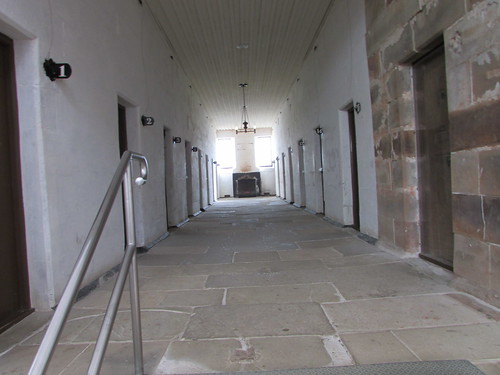
Port Arthur Historic Site: Cells in the Separate Prison.
In the 1860s, an aging population of convicts lead to the so-called 'welfare phase'. The Asylum, dating from 1863, provided basic care for the mentally ill. Having subsequently been rebuilt and used as a school, town hall and museum, it survives as a poignant reminder of earlier days.
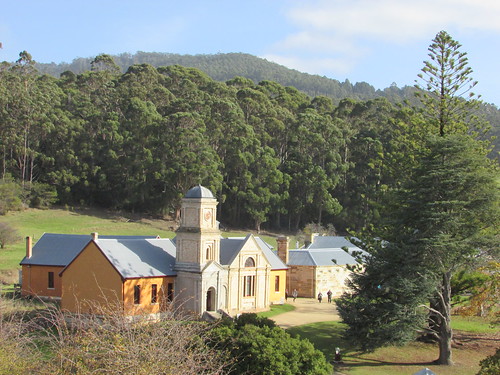
Port Arthur Historic Site: The Asylum.
Use as a penal settlement finally ceased in 1877, after which the location was renamed Carnarvon, the land was auctioned and, despite suffering serious fires, settlers created a viable community. The unsavoury history of the area served as a magnet for tourists. In 1927, the name reverted to Port Arthur and the tourist trade supported 3 hotels, 2 museums and numerous guides. The former Commandant's House became 'The Carnarvon Hotel' in 1885 and the building has been restored to reflect that period.

Port Arthur Historic Site: The Commandant's House, restored in the period of 'The Carnarvon Hotel'.
Although many of the original buildings have been damaged (or destroyed), what remains has been carefully preserved to give an eerie insight into the prison regime.
I walked around the site, from building to building, taking photographs and trying to absorb the enormity of the earlier history. My party was booked on the 1.40 p.m. harbour cruise in a modern catamaran so I had to hustle to get to the boat in time - I could have spent much longer exploring the site.
The harbour cruise gave interesting views of Port Arthur and also berthed at the Island of the Dead - Port Arthur's cemetery for both convicts and free men. Here, visitors booked on an optional walking tour of the small island disembarked and we picked up visitors from an earlier walking tour.
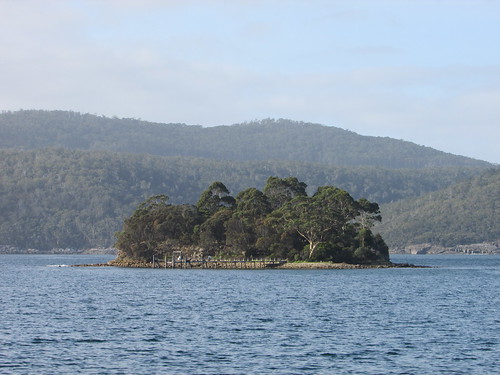
Port Arthur Historic Site: The Island of the Dead.
The autumn sun shone benignly throughout and, seeing the site as a visitor remaining just a few hours, the site was beautiful. An unexpected comparison sprang to mind - I was reminded of the television series 'The Prisoner' (there's a Wikipedia article here) which was filmed in Portmerion, Wales. My album of pictures taken at Portmerion is here.
On the long drive back to Hobart, we made various stops at natural sea-related land formations - Tasmans Arch, the Devil's Kitchen, the Blowhole.
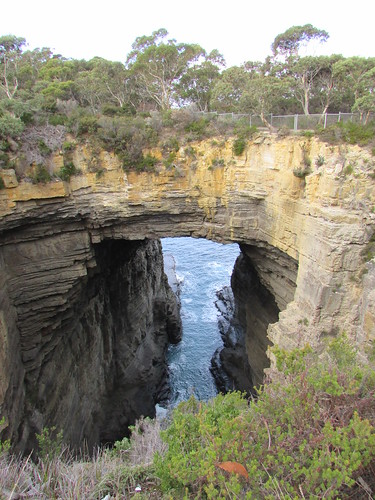
Port Arthur to Hobart: Tasmans Arch.
Interesting, but not the thought-provoking experience the Heritage Site at Port Arthur had furnished.
Related Posts on this Website
All Burma-2017 Trip posts.
All Australia-2017 posts.
My Pictures
The Henry Jones Art Hotel, Hobart.
Hobart, Tasmania.
Richmond, Tasmania.
Hobart to Port Arthur.
Port Arthur Historic Site. Port Arthur to Hobart.
[Links to pictures added 18-Aug-2017: Text added, pictures added 14-Sep-17]
